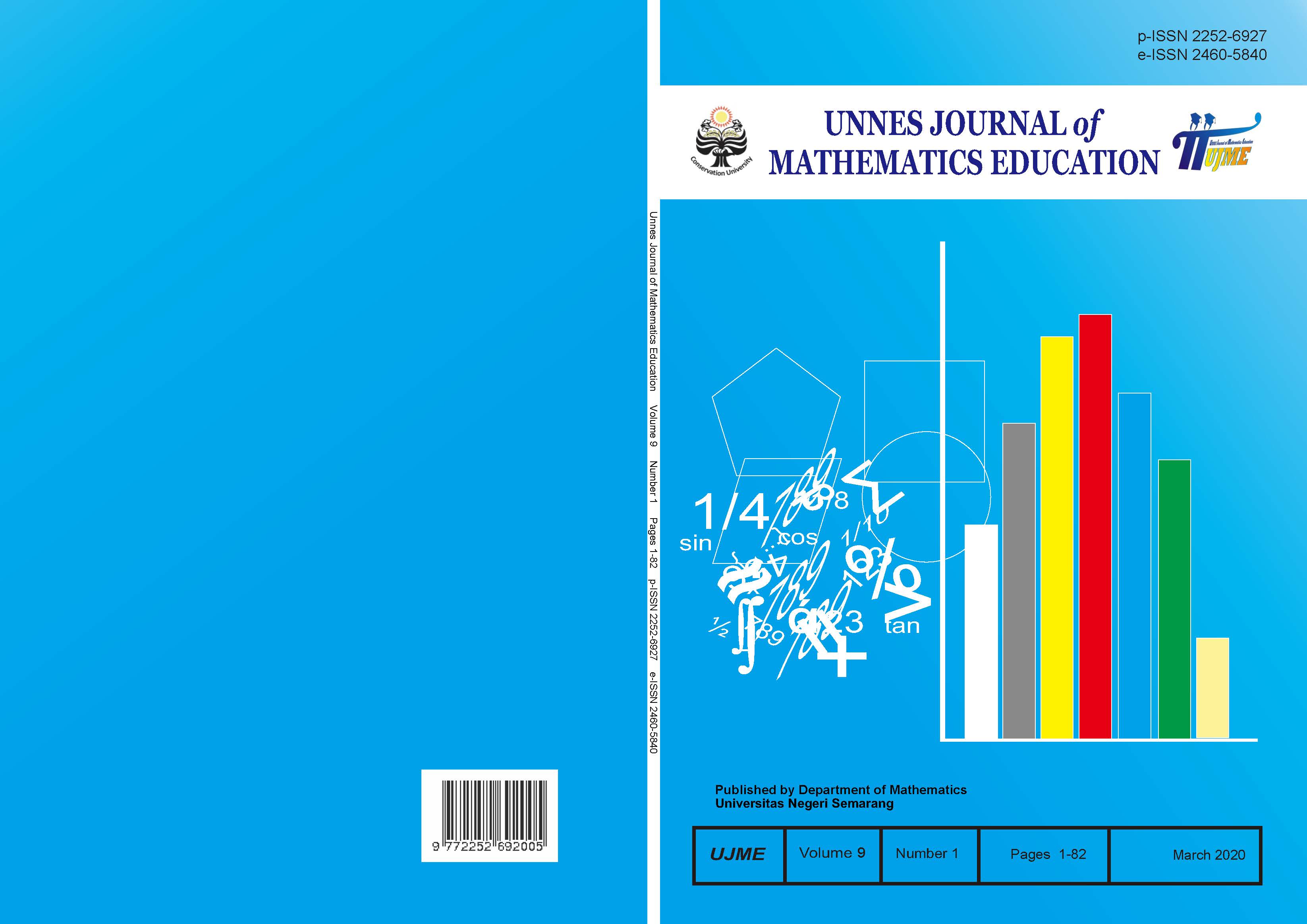Mathematical reasoning ability based on students anxiety in STAD learning with performance assessment
##plugins.themes.academic_pro.article.main##
Abstract
Mathematical reasoning ability is very important for students in solving a problem, but the Indonesian student’s mathematical reasoning ability is still not optimal. The purpose of this research is (1) to test student’s mathematical reasoning abilities in Student Team Achievement Division (STAD) learning with Performance Assessment achieving learning completeness, (2) to describe mathematical reasoning abilities based on student anxiety in STAD learning with Performance Assessment. This research is a mixed methods research with concurrent embedded design. The population in this study were students of grade VIII Islamic Junior High School in Kendal Central Java in the 2018/2019 academic year. Random sampling technique is used as a sampling method and the subject is determined with a purposive sampling technique. The results showed that STAD learning with Performance Assessment achieved classical completeness, namely more than 75% of students who participated in STAD learning with Performance Assessment reached 70 scores. Mathematical reasoning ability of students with low anxiety described as very good in fulfilling all indicators of mathematical reasoning ability i.e. submitting guesses, doing manipulation/mathematical calculations, drawing conclusions, and giving reasons for solutions. Mathematical reasoning ability of students with medium anxiety described as fulfilling indicators submitting guesses, doing manipulation/mathematical calculations, and drawing conclusions. Description of mathematical reasoning abilities of students with high anxiety is only able to fulfill the indicator of submitting guesses. In other indicators of mathematical reasoning ability, students with high anxiety are less able to understand the problem well.
##plugins.themes.academic_pro.article.details##
References
Blazer, C. 2011. Strategies for Reducing Math Anxiety. Information Capsule. Research Services, Miami-Dade County Public Schools. Volume 1102.
Chusna, C.A, Kartono, Edy S. 2017. Analisis Kemampuan Penalaran Matematis Siswa Kelas VIII Materi Balok dan Kubus Melalui Pembelajaran Model Think Pair Share Berbantuan Problem Card. Unnes Journal of Mathematics Education. Vol 6 No 3
Cooke, A., Rob C., Chris H., & Len S. 2011. Situational Effects of Mathematics Anxiety in Pre-service Teacher Education. Australian Association for Research in Education
Daneshamooz, S., & Alamolhodaei, H. 2012. Cooperative Learning And Academic Hardiness On Students Mathematical Performance With Different Levels Of Mathematics Anxiety. Educational Research. Vol 3 No. 3: 270-276.
Das, R & Gunendra C. D. 2013. Math Anxiety: The Poor Problem Solving Factor in School Mathematics. International Journal of Scientific and Research Publications.Vol. 3 No. 4: 745-753.
Fadlilah U., Budi U., & Sri S. 2015. Eksperimentasi Model Pembelajaran Problem Based Learning dan Discovery Learning dengan Pendekatan Saintifik pada Materi Segiempat Ditinjau dari Kecemasan Belajar Matematika Siswa SMP Negeri Kelas VII di Kabupaten Banyumas. Jurnal Pembelajaran Matematika. Vol 3 No 8.
Isnaeni, S., Lailatul F., Evi SR., Ratni., & Wahyu H. 2018. Analisis Kemampuan Penalaran Matematis dan Kemandirian Belajar Peserta didik SMP pada Materi Persamaan Garis Lurus. Siliwangi: IKIP Siliwangi. Journal of Medives, 2(1): 107-115.
Jubaida, A. 2015. Keefektifan Model PBL dengan Teknik Radiant Thinking Terhadap Kemampuan Problems Solving dan Kemandirian Siswa pada Pembelajaran Bangun Ruang kelas VIII. Skripsi. Semarang. Universitas Negeri Semarang
Mahmood, S & Tahira K. 2011. Development and Validation of the Mathematics Anxiety Scale for Secondary and Senior Secondary School Students. British Journal of Arts and Social Sciences. Vol. 2 No. 2: 169-179.
Masrukan. 2014. Asesmen Otentik Pembelajaran Matematika Mencakup Asesmen Afektif dan Karakter. Semarang: FMIPA Unnes.
Ratnasari, R., Mardiyana, M., & Budi U. (2015). Eksperimentasi Model Pembelajaran Kooperatif Tipe Two Stay Two Stray dengan Pendekatan Saintifik dan Tipe Teams Assisted Individulization dengan Pendekatan Saintifik pada Materi Himpunan Ditinjau dari Kecemasan Belajar Matematika Siswa. Journal of Mathematics and Mathematics Education. 5(1).
Sa’dijah. 2009. Assesmen Kinerja dalam Pembelajaran Matematika. Jurnal pendidikan inovatif.
Sugiyono. 2015. Metode Penelitian Pendidikan (Pendekatan Kuatitatif, Kualitatif dan R&D). Bandung: Alfabeta.
Suherman, E. 2003. Strategi Pembelajaran Matematika Kontemporer. Bandung: Universitas Pendidikan Indonesia.
Yenilmez, K., Girginer, N., & Uzun, O. 2017. Mathematics Anxiety and Attitude Level of Students of the Faculty of Economics and Business Administrator: The Turkey model. International Mathematical Forum. Vol. 2 No. 41. 1997-2021.
Zakaria, E & Norazah MN. 2008. The Effects of Mathematics Anxiety on Matriculation Students as Related to Motivation and Achievement. Eurasia Journal of Mathematics, Science & Technology Education. Vol. 4 No. 1: 27-30.
